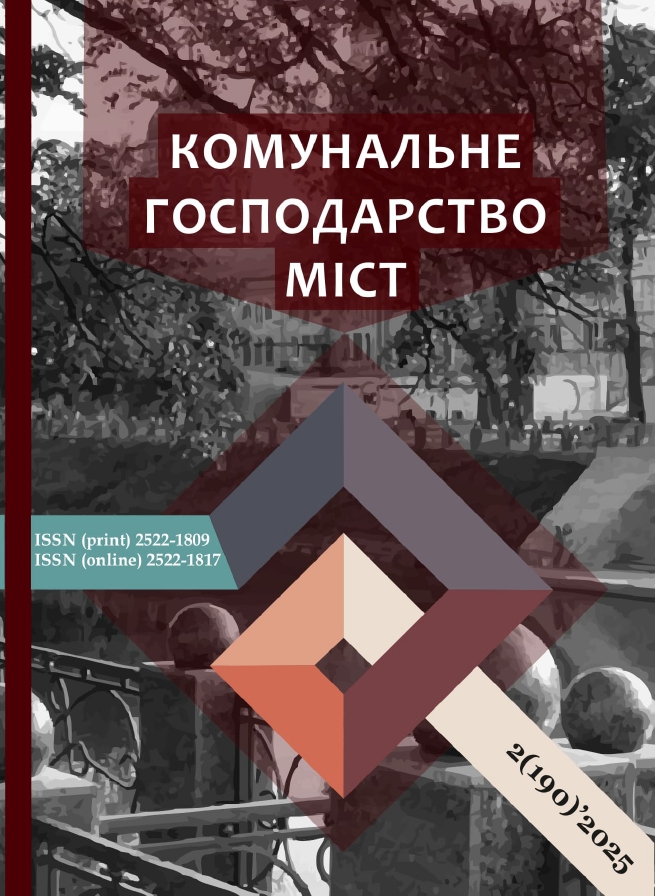KEY CHARACTERISTICS OF WAR-RELATED DEBRIS AND THEIR IMPLICATIONS FOR LOCAL WASTE MANAGEMENT
DOI:
https://doi.org/10.33042/2522-1809-2025-2-190-56-62Keywords:
waste management, local territorial communities, post-war recovery, hazardous waste, circular economyAbstract
The article explores the specific nature of debris and waste generated as a result of military aggression and large-scale destruction of infrastructure in Ukraine, especially within the boundaries of local communities. The authors emphasize that such waste represents a particularly complex category for public management due to the combination of three systemic features: its massive scale, unpredictable and heterogeneous composition, and the presence of various hazardous properties. The study analyzes the current regulatory framework governing such waste and reveals its fragmentation and lack of alignment with the practical challenges faced by war-affected communities. Particular attention is given to the lack of technical and institutional support for local governments, which are tasked with implementing basic waste management operations such as identification, collection, transportation, and sorting. The article outlines the typical sources of war-related debris in various types of communities, classifies the main fractions of such waste, and describes the associated environmental and human health risks. The research highlights the urgent need for an interdisciplinary and multisectoral approach that integrates engineering analysis, ecological monitoring, logistical planning, and regulatory reform. Promising directions for future research are formulated, including the development of adaptive local governance models, mobile waste-sorting infrastructure, national standards for material reuse, digital risk monitoring tools, and intermunicipal coordination mechanisms. The findings are highly relevant for planning sustainable post-war recovery in Ukraine, ensuring environmental integrity and public safety.
References
World Bank, European Commission, United Nations, & Government of Ukraine. (2024). Ukraine fourth rapid damage and needs assessment (RDNA4). https://documents1.worldbank.org/curated/en/099022025114040022/pdf/P180174-ca39eccd-ea67-4bd8-b537-ff73a675a0a8.pdf
Cabinet of Ministers of Ukraine. (2022, September 27). Procedure for waste management generated as a result of damage (destruction) to buildings and structures caused by hostilities, terrorist acts, sabotage or activities aimed at eliminating their consequences (Resolution No. 1073). https://zakon.rada.gov.ua/laws/show/1073-2022-п#Text
Трегуб О. (2023). Правові аспекти управління відходами від руйнування будівель та споруд, що утворюються внаслідок бойових дій. Law. State. Technology, 4, 16–22, doi: 10.32782/LST/2023-4-3
Novak, T. S., & Ermolenko, V. M. (2025). Certain aspects of legal support for the management of waste generated due to damage (destruction) of buildings and structures as a result of hostilities. Analytical and Comparative Jurisprudence, (1), 368–372. https://doi.org/10.24144/2788-6018.2025.01.59
Gafurova, O. V., & Novak, T. S. (2023). Information on waste generated as a result of war: the issue of legal protection. Scientific Bulletin of Uzhhorod University: Law Series, 1(79), 349–355. http://visnyk-pravo.uzhnu.edu.ua/article/view/288633/282292
Potip, M. M. (2023). Legal regulation of the activities of local government bodies in the field of disposal of war waste. Law Bulletin, (29), 98–110. http://www.lawbulletin.oduvs.od.ua/archive/2023/29/11.pdf
Patseva, I., & Nonik, L. (2023). Recycling of destruction waste is a step towards reducing the risks of military ecocide. Problems of Chemistry and Sustainable Development, 3, 73–81. https://doi.org/10.32782/pcsd-2023-3-10
Nonik, L. Yu., Patseva, I. H., & Pichkur, T. V. (2023). Waste management strategies for handling hazardous debris during war. Environmental Safety and Environmental Protection Technologies, (4), 40–46. http://eztuir.ztu.edu.ua/123456789/8292
Drozd, O. V. (2023). Examination of destruction of waste by means of structural degradation signs of materials and prospects for recycling. Scientific Notes of V. I. Vernadsky Taurida National University. Technical Sciences Series, 34(73)(4), 176–182. https://doi.org/10.32782/2663-5941/2023.4/28
Herasymchuk, L. O. (2023). Military actions as a factor of waste formation. Tavria Scientific Bulletin, (133), 305–312. https://doi.org/10.32782/2226-0099.2023.133.41
United Nations Environment Programme. (2022). The environmental impact of the conflict in Ukraine: A preliminary review. Nairobi: UNEP. https://www.unep.org/resources/report/environmental-impact-conflict-ukraine-preliminary-review
United Nations Development Programme. (2024). Impact of the war on solid waste management in the Gaza Strip. New York: UNDP. https://www.undp.org/arab-states/publications/gaza-insights-impact-war-solid-waste-management-gaza-strip
ReliefWeb. (2025, April). Lessons learned from Iraq and Syria debris management and rubble clearance. Geneva: ReliefWeb. https://reliefweb.int/report/syrian-arab-republic/lessons-learned-iraq-and-syria-debris-management-and-rubble-clearance-april-2025
Abu Hamed, H., Al Bursh, W., Abu Mfarreh, S., & others. (2023). Managing post-conflict demolition wastes in Gaza Strip: A case study on May 2021 conflict. Journal of Material Cycles and Waste Management, 25, 684–693. https://doi.org/10.1007/s10163-022-01570-y
Ali, A., & Ezeah, C. (2017). Framework for Management of Post-Conflict Waste in Libya. European Scientific Journal, ESJ, 13(5), 32. https://doi.org/10.19044/esj.2017.v13n5p32
United Nations Development Programme. (n.d.). Guidance note: Debris management. Crisis Prevention and Recovery. https://www.undp.org/sites/g/files/zskgke326/files/migration/ba/UNDP-Guidance-note-Debris-Management.pdf
Resync NGO. (2024). Methodological recommendations for assessing the volume of demolition waste. 68 p. https://drive.google.com/file/d/1kRTrZc6ColOQRPY_6z45uVKjBWa4u5dG/view
Downloads
Published
How to Cite
Issue
Section
License
The authors who publish in this collection agree with the following terms:
• The authors reserve the right to authorship of their work and give the magazine the right to first publish this work under the terms of license CC BY-NC-ND 4.0 (with the Designation of Authorship - Non-Commercial - Without Derivatives 4.0 International), which allows others to freely distribute the published work with a mandatory reference to the authors of the original work and the first publication of the work in this magazine.
• Authors have the right to make independent extra-exclusive work agreements in the form in which they were published by this magazine (for example, posting work in an electronic repository of an institution or publishing as part of a monograph), provided that the link to the first publication of the work in this journal is maintained. .
• Journal policy allows and encourages the publication of manuscripts on the Internet (for example, in institutions' repositories or on personal websites), both before the publication of this manuscript and during its editorial work, as it contributes to the emergence of productive scientific discussion and positively affects the efficiency and dynamics of the citation of the published work (see The Effect of Open Access).

